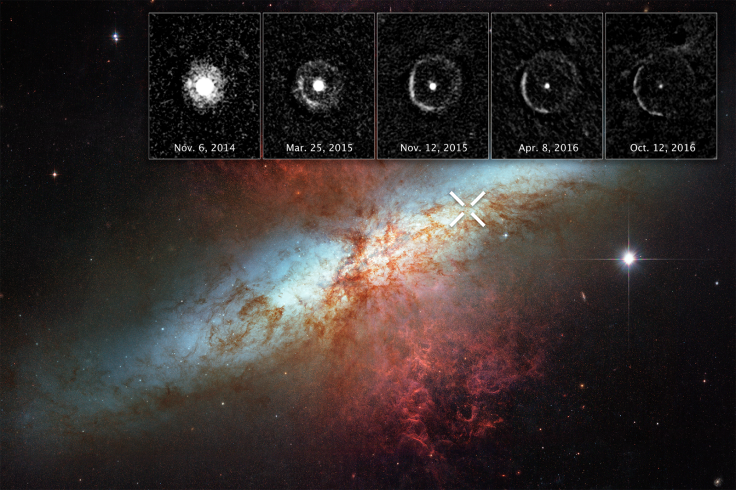NASA’s Hubble Spots ‘Light Echo’ From Nearby Supernova Explosion
A white dwarf star exploded as a Type Ia supernova over 11 million years ago and a shell of light from it is expanding and sweeping through interstellar space, NASA’s Hubble Space Telescope has found. While the supernova itself was spotted by Hubble in 2006, the shell of light was imaged between November 2014 and October 2016, NASA said in a statement Thursday.
As it moves through space, the light produced from the explosion “is bouncing off a giant dust cloud that extends 300 to 1,600 light-years from the supernova and is being reflected toward Earth,” NASA said. This shell of light rippling through the vastness of the universe is called a “light echo.”
The supernova that caused the light echo is called SN 2014J and it is located 11.4 million light-years away in the M82 galaxy, making it the closest Type Ia explosion to Earth in at least 40 years. A Type Ia supernova occurs in a binary star system which has a white dwarf and a companion star. The white dwarf is the one that goes supernova after its partner dumps more material into it than it can handle.

M82, also called the Cigar Galaxy, is a spiral galaxy that was first considered an irregular galaxy. It gets the Cigar name due to its perceived elliptical shape, given its tilt from Earth’s point of view. It is also a starburst galaxy, which is to say, it is forming new stars at a very rapid pace. This is likely caused by its interaction with the neighboring M81 spiral galaxy, which leads to compression of gas in M82, NASA explained in the statement.
The galaxy, which is also a part of the Messier Catalog of non-comet objects, is about five times more luminous than our home galaxy and its center is one hundred times brighter than the Milky Way’s center.
It was discovered by Hubble in 2006 using its Advanced Camera for Surveys, and the supernova SN 2014J was spotted Jan. 21, 2014, using the same instrument. Hubble images of the galaxy show “a bright blue disk, webs of shredded clouds, and fiery-looking plumes of glowing hydrogen blasting out of its central regions.” They are also the most detailed record ever of a Type Ia supernova.
Hubble is a collaboration between NASA and the European Space Agency.
© Copyright IBTimes 2024. All rights reserved.











